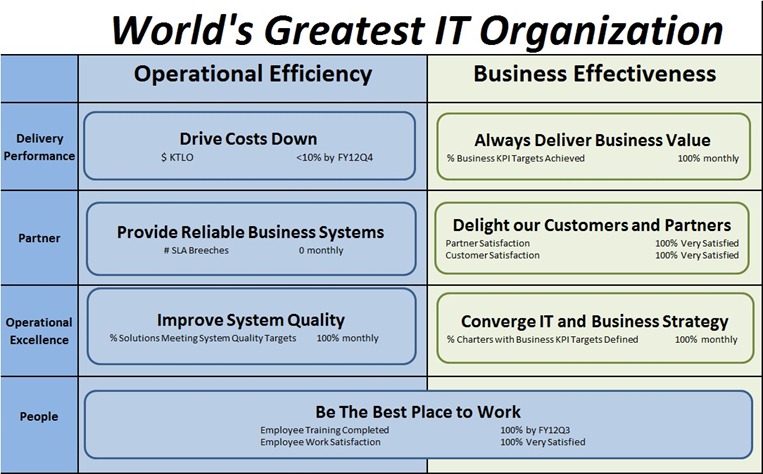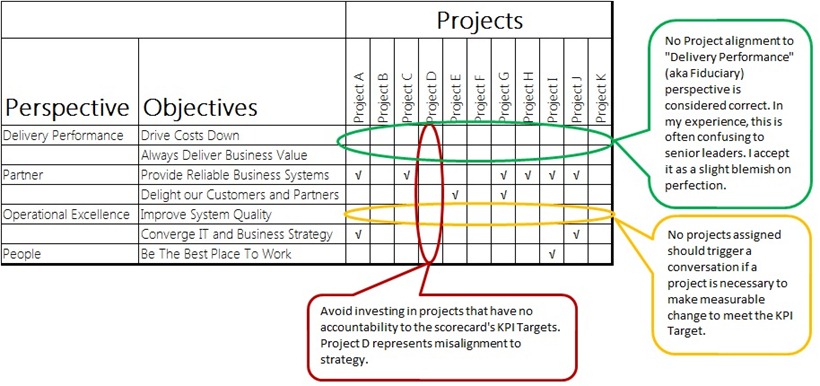Business Architecture is Business Performance Management with Engineering Rigor
I’ve been performing a Business Architect role within the Enterprise Architecture function over the past few years and wanted to share some opinions I’ve formed to help jog, and possibly advance, the thinking in the space of Business Architecture by colliding Traditional Business Architecture with business management processes like Business Performance Management.
Traditional Business Architecture needs refinement to drive business success
After using some of what I call ‘Traditional Business Architecture’, I found that teams are at high risk of failure toward helping companies achieve success. I’ve been part of, and witnessed other groups, implement Traditional Business Architecture concepts that over-simplify “the business” and result in analysis paralysis from focusing on the wrong things and/or getting caught in trying to manage unbelievable amounts of information that quickly turns into a non-sustainable investment. In my opinion, Business Architecture is foundational to the success of any company in a competitive market and a vital part of a successful Enterprise Architecture function so I’ve taken the time to write down some observations as a means of making a pass at refining the concept of Business Architecture and help folks sift through and apply what’s already there.
Let’s start with a simple overview of what I’ll term ‘Traditional Business Architecture’ in this article. I see Traditional Business Architecture as the collection of the popular methods and models describing Business Architecture such as Gartner EAF, TOGAF standard, ArchiMate, FEAF, Zachman, Total Quality Management, Six Sigma, LEAN and CMMI. I know what you are thinking “did he just say that those incredibly popular Architecture industry frameworks are ingredients for a failed Business Architecture function?” Well, yes, I am saying that. Don’t get me wrong, these are all useful to some degree if applied appropriately. However, by themselves either individually or collectively they are fraught with high risk of failure assuming success of Business Architecture as part of an Enterprise Architecture function is defined as the company’s success. I’m carefully choosing my words here because I realize how my message could be misinterpreted. Let me say it again to avoid misinterpretation, “Implementing Traditional Business Architecture is at high risk of failure toward helping companies achieve success “.
Reader: |
“Oh, no he didn’t!” |
Gabriel: |
“Well, yes, I did.” |
Reader: |
“Ohhh myyyy.” |
Instead of critiquing each Traditional Business Architecture model and techniques and highlight the risks to driving a company’s success, I’ll describe how adoption of a few business management concepts with a dash of engineering rigor get us a refined description of Business Architecture. From there, you can do the math to compare to the industry frameworks and highlight the risks for yourself.
Business Architecture engineers the business for Success
Business Management is essentially about defining what business success looks like and lining up the organization to execute it. Business Architecture is about applying engineering to business concepts to capture the definition of business success in a well-defined model and providing analysis to shape and optimize the project portfolio to achieve it. In a sense, Business Architecture is simply applying engineering to the Business Management discipline.
Sidebar: What is a Business? From a Business Management perspective, all organizations within a company are classified into two types; Business and Business Support . If an organization builds a product or service which generates revenue, it is a Business organization. All other organizations are Business Support organizations. A ‘Line of Business’ is a synonym for a Business organization. Examples of Business organizations are Product Teams and Business Services. Examples of Business Support organizations are Marketing, Sales, Support, Human Resources, Operations, Legal, Finance and IT. |
Focus on Success via Business Performance Management
In Business Management, Business Performance Management is the most effective process for delivering business performance. There are several variations of business performance management processes out there and the balanced scorecard is by far the most widely successful method.
Sidebar: What is Business performance management? Business Performance Management is a set of management and analytic processes that enable the management of an organization's performance to achieve one or more pre-selected goals . |
In a single business, the balanced scorecard provides a thorough means of articulating success to achieve the business organization’s Vision and the necessary project investments to achieve success. The balanced scorecard takes into account the causal nature of defining success for the organization’s people, then process, then customer perceptions as well as the broader organization’s stakeholders. The business’ balanced scorecard is used by the relative Business Support organizations to derive their own balanced scorecard via a process called cascading. From a Business Architecture perspective, the balanced scorecard provides a clear definition of success via date-bound Key Performance Indicator (KPI) Targets. The KPI Targets, in combination with an architecturally sound solution expressed in terms of process, information and system architectures, describe the project’s scope. The end result is a business strategy and subsequent Business Support strategies inclusive of well-defined KPI Targets mapped to a project portfolio where each project in the portfolio is accountable to deliver to the specific KPI Targets found in balanced scorecards. Business Architecture enables this by ensuring traceability from the balanced scorecard to the project portfolio and making sure that rigorous engineering was involved to describe the project scope to be delivered; KPIs, process, information and system architecture together. In summary, the balanced scorecard and Business Architecture discipline provide a well-engineered closed-loop business performance management process entirely focused on the business’ success.
To take the above to the next level of sophistication and address external and internal triggers to change the business, a business management process called strategy formulation is required. Strategy formulation processes like Porter’s 5-Forces, Blue Ocean and SWOT are designed to analyze an organization’s environment with the intention of mitigating risk and leverage competitive advantage. Business Architecture enables strategy formulation again by providing a structured model to capture external and internal signals and perform traceability from external and internal signals to the balanced scorecard’s KPI Targets. A typical example of an external signal triggering a change in a business’ balanced scorecard would be the observation of a competitor gaining market share. An example of an internal signal would be the observation of internal systems that continue to breach availability or performance Service Level Agreement thresholds. Business Architecture enables this broadened closed-loop system by mapping project investments to achieve KPI Targets that are traced to to external or internal signals.
Sidebar: Balanced Scorecards aren’t only for STRATEX. Although some balanced scorecard methodologies focus on its use for STRATEX, I’ve successfully used balanced scorecards for managing Business and Business Support organization’s portfolio spend. For Business Support organizations, using the basic balanced scorecard technique can be a particular challenge because there is little guidance how to account for typical operating performance (ie CAPEX and OPEX) as well. Drs. Kaplan and Norton published the article Aligning Support Functions and introduced the themes “Business Effectiveness” and “Operational Efficiency” as means of prescribing how to balance a strategy of a Business Support organization with the Business(es) they serve. I’ve taken the concept to manage entire portfolios and highly recommend it. |
We need to augment Business Performance Management and
Business Architecture techniques to support an enterprise
Up to now, I’ve highlighted business performance techniques for a single business (and enabling Business Support organizations). The moment we broaden the scope to a large enterprise with several businesses, what’s been described so far won’t scale and we need to augment our techniques to make business performance management work. To avoid confusing customers with the various products and services offered as well as provide a logical method to optimize each business’ customer value stream, we group products and services via business models based on the Customer Value Proposition the company’s products and services provide. The most proven business management technique for doing this is Alex Osterwalder’s Business Model Canvas. From a business management perspective, the Business Model Canvas provides a technique for a company to organize businesses and form partnerships to collaborate and exploit their competitive advantages to outperform the competition through maximizing Customer Value and reducing operating costs. From a Business Architecture perspective, the Business Model Canvas provides a simple classification structure to organize business architecture elements; Partners, Activities (think process), Value Propositions, Customer Relationships, Channels, Customer Segments etc. From my experience, understanding a single business’ business model is important but not critical. In the situation of a large enterprise with several businesses, understanding the companies business’ business models is very important to get right. To be honest, I’m still learning how to do this scientifically because it’s not obvious where business model lines are drawn as the number of combinations of Business Model Canvas elements is extremely high. I tend to focus on businesses in sets framed by commonalities in Customer Value, Channel and Customer Segment then work with businesses directly to refine as appropriate. In my experience, I’ve observed about 4 business model distinctions that seem to be useful for Business Architecture work; Service Provider, Physical Product, Keystone, and Enterprise Partner. Anyway, once businesses are grouped by business models, simply apply business performance management and business architecture techniques like we would for a single business with the exception that we need to add horizontal balanced scorecard cascading between the businesses. The result is synergy of business strategic targets and project alignment across business boundaries down through their Business Support organizations. What doesn’t get covered is a layer of refinement to identify opportunities for optimizing project spend by avoiding project redundancies in terms of projects delivering solutions to the same process space. To optimize the project portfolio and avoid project overlaps, the Business Architecture technique of cross-portfolio analysis by grouping projects based on a common process framework (aka business capability model and business process models) is used. Also note that Business Architecture intersects the Solution Architecture discipline at this point to identify further opportunities to reduce project spend by reuse of enterprise platforms through system dependency analysis. The result is an enterprise-wide model describing interconnected business strategies per business model where business KPI Targets are directly mapped to project portfolios that have been optimized to avoid gaps and overlaps as well as leveraging enterprise platforms.
Here’s a heavily cleansed example of a Balanced Scorecard for an IT organization here within Microsoft. Note that I’ve modified it to be more illustrative of the concepts in this blog post. Just drop me a comment if you’d like me to add clarity. Note that I combine the Strategy Map and Balanced Scorecard KPI data together as it makes it easier for the information to be on a single view. Also, I made some modifications to suit the organization I served. For example, I changed the perspective names a bit as well as the theme “Partner Effectiveness” to better align to terminology used in the organization.
For those new to the concept of Strategy Map, essentially a Strategy Map is a set of Objectives organized by the four balanced scorecard perspectives. The way to think about the relationship between Objective and KPI Targets is assume the KPI Targets a measurable proof the organization has achieved the Objective.
Here’s another illustrative example of a project portfolio anchored in the context of a balanced scorecard to help with the analysis of project-to-strategy alignment. This view is something I use internally to help identify misalignments or other anomalies that trigger conversations about whether we’ve got the right set of projects defined to achieve our objectives.

